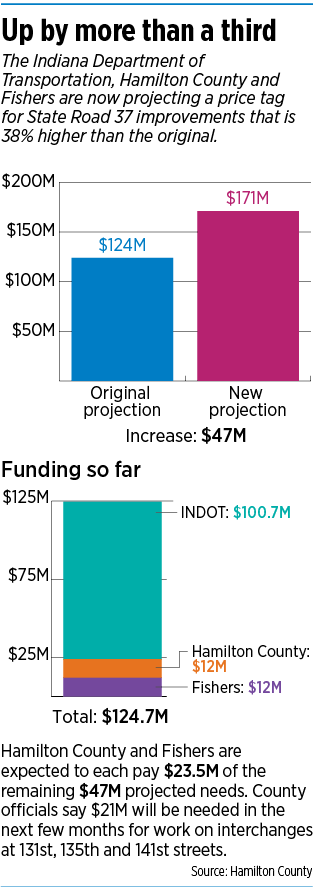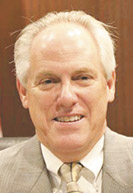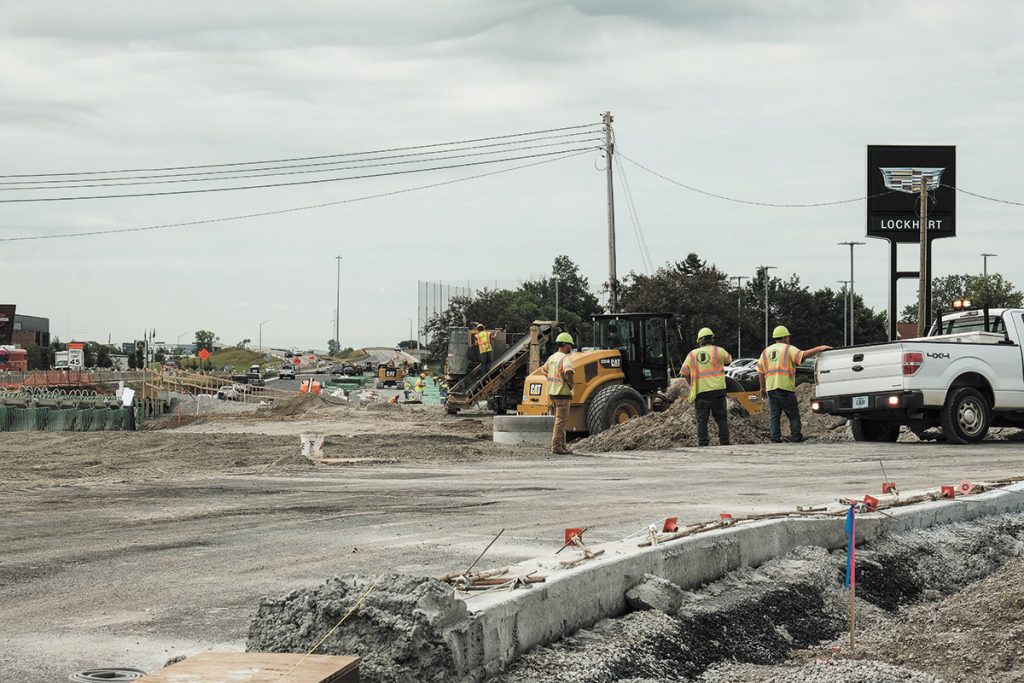Subscriber Benefit
As a subscriber you can listen to articles at work, in the car, or while you work out. Subscribe NowWork is underway on the first of five planned interchanges along State Road 37, and already, local officials are estimating the corridor improvements will run $47 million over the project’s original $124 million budget.
Fishers and Hamilton County officials are blaming a bad drainage estimate, unexpected utility relocations and costly land acquisitions for why improvements to State Road 37 from 126th to 146th streets might cost 38% more than anticipated.
The joint city, county and state project is now expected to cost $171 million, and the completion date has been pushed back two years—to late 2023.

“The drainage, the change orders, the inspections, the utility relocations, the right-of-way, the design—it all contributed to that higher number,” said Hatem Mekky, Fishers’ assistant director of engineering.
The Indiana Department of Transportation announced in 2015 that it would commit $100 million to improvements along State Road 37—including four at-grade interchanges—as long as the city of Fishers and Hamilton County each contributed $12 million.
Those local contributions have been spent, according to Fishers Mayor Scott Fadness, and the local agencies are now each responsible for an additional estimated $23.5 million.
“This has been a long journey. We’ve had several different twists and turns, but the good news is, we have about 75% of the project bid,” Fadness said. “I’m cautiously optimistic that, at the end of the day, it will not be” a $47 million overage.

Hamilton County Commissioner Christine Altman and other county leaders aren’t so optimistic. Altman said she’s certain the project will be significantly overbudget if it’s built according to plan.
“When you’ve got a big conceptual project, the costs often aren’t what you initially thought they’d be,” Altman said. “I don’t think anybody entered into bad faith by presenting a project that wouldn’t meet that budget.”
Money pit
In 2015, the year it transitioned from being a town to a city, Fishers took the lead on the project, which is aimed at alleviating congestion and public safety challenges on a two-mile stretch of highway that often experiences gridlock.

After putting the project’s drainage evaluations out to bid, Fishers awarded much of the work to New York-based engineering firm WSP Parsons Brinkerhoff, which is now called WSP USA.
According to the city of Fishers, WSP estimated its part of the project’s drainage system would cost $5 million. But the actual cost is about $21.7 million.
City and county officials blame WSP for the wildly off-base estimate.
“We ran into a drainage plan we thought would be inexpensive and it turned out to be horrendously expensive,” Altman said. “They got into design and they found out they were just plain wrong.”
WSP said in a statement to IBJ that “realities on the ground”—discovered after its original estimate—affected the way the drainage system needed to be constructed. “Design changes impacting the required size, length and depth of pipes evolved through the life of the project,” the statement said.
Altman said WSP provided its estimate when the project was still early in the design process. She said officials can’t hold WSP liable for the added cost.

“One of the things that people didn’t realize at the beginning is that it would cost that much to do. This was specialty work,” said Brad Davis, director of the Hamilton County Highway Department.
WSP’s drainage solution involves creating a series of pits bored to connect with 54-inch drainage tunnels running to the White River.
Fadness said the drainage approach likely will save Fishers money on maintenance over time.
“If there is a silver lining to that, it’s that the drainage system we’ve put in place is not a lift system. It’s gravity, so it’s literally a pipe that drains water down to the river,” he said.
Other surprises
Fishers officials say the remainder of the nearly $47 million in overruns stems from higher-than-expected utility relocations and ongoing land acquisitions.
For example, Fadness said, moving a single Hamilton Southeastern sewer line under 141st Street might cost more than $3.4 million—and that’s just one of several planned utility relocations.
After intially estimating $1.9 million in utility relocation costs, the city now anticipates that portion of the project will run over budget by $6 million.
Mekky said it’s hard to predict how much utility relocations will cost. The city won’t receive bills for those projects until they’re completed, so there’s potential for additional cost surprises.
“With projects of this magnitude, there are a lot of guesstimates,” he said.
The city also is seeing costs increase as it acquires adjacent rights-of-way. Mekky said the city already procured easements for drainage projects along 126th and 146th streets. A handful more will be needed for the 135th and 141st street intersections.

Fadness said land acquisition has also been more expensive and slower-going than envisioned.
To date, the city estimates those acqusitions have cost nearly $10 million. That’s about $2 million more than was originally anticipated.
“They’ve been more litigious than an average road project. That being said, part of the reason behind that is, you’re dealing with a lot of sophisticated businesses,” he said.
“They understand the process and are willing to fight in court more so than the average citizen, but we’re close to having most of those wrapped up.”
Construction material and labor costs have also risen since 2015. The city of Fishers estimates construction costs are now $11 million beyond the original $112 million estimate.
Planners have tried to scale back some aspects of the project to offset overruns but have largely been unsuccessful.
For example, Mekky said project leaders recently considered redesigning the interchange at 141st Street as a right-in, right-out intersection. However, the idea was criticized by the public as an insufficient alternative.
“Right-in, right-out would’ve been cheaper at face value, but we found the impact to 146th Street would’ve actually made it more expensive,” he said. “We have to go through these exercises to make sure we’ve looked at all of the other available options.”
Project planners have moved forward with other changes to improve traffic flow. For example, the 146th Street interchange was designed as a double roundabout. However, after the county and INDOT studied traffic patterns, they concluded a single-point intersection was a better fit.
Pointing fingers
Hamilton County officials say they could have avoided overruns of this magnitude had they, rather than Fishers, taken the lead on the project.
“At the county, we are not used to cost overruns on projects. If anything, we’re used to bringing them [in] under budget,” Hamilton County Commissioner Mark Heirbrandt said.

Rick McKinney, Hamilton County Council president, said he was surprised to see such high cost overruns when the commissioners and council met in June.
“In the end, everybody will clap hands, hold hands and say it was a wonderful success, but it’s a lot of money overspent on design and construction engineering without a whole lot of oversight from the county,” McKinney said.
“Fishers was out of their element in my opinion. Without question, the county could’ve led this project better.”
Ashley Elrod, spokewoman for the city of Fishers, said city officials are confident in their ability to manage a project of this magnitude.
“Over the last five years or so, Fishers engineering itself has managed, designed and built nearly $100 million in projects outside of State Road 37—and that’s without the help of the county or the state,” Elrod said. “We’ve proven that time and time again on other projects.”
Fishers and Hamilton County aren’t shouldering the entirety of the project’s increased costs. According to Hamilton County, INDOT’s commitment has grown to $100.7 million and the state has offered to provide inspections at no additional cost. “We, as locals in the county, would’ve had to pay for that inspection. We would’ve had to have bid that contract out and given it to an inspection company,” Mekky said.
Altman said county officials plan to meet with Fadness next month to discuss paying for the overruns. Neither the county nor the city has formally dedicated additional funds, although both might issue bonds to pay some of the cost.
“We’ve been looking at a long-range financial plan,” Fadness said. “We feel pretty confident we’ll be able to take on those infrastructure costs and not unduly burden our residents.”
Altman said the commissioners have already asked the council for a roughly $5 million appropriation to cover a portion of the additional costs, but that proposal won’t be heard until August.
She said that, if she were on the council, she would suggest issuing bonds backed by the county’s share of the local income tax.
“That way, the people who enjoy the improvements would be paying for them over time,” Altman said.•
—
Correction: The scope and price of work done by WSP USA has been corrected. In addition, a comment from WSP has been added to the story.
Please enable JavaScript to view this content.


$85 million per mile? Wow.
In contrast, upgrading IN37 to I-69 Section 6 will cost $1.5billion for 26 miles, or a little under $58 million per mile…and that includes a mile or so of new terrain north of Southport Rd. that requires buying out a lot of commercial/industrial real estate and significant widening of I-465 for a mile or more on each side of the junction.
I am a little disappointed there was no mention of the hurried process in getting this project done to help Gov Pence.
Probably because it’s just in your head. Please elaborate on your conspiracy theory…
Hurried process? This has been on the planning boards since 1999 or before.
In these government run projects, low bid wins. Too often, you get, or do not get; what you pay for. Disappointed in our leaders for not doing a better job of vetting contractors for a project of this magnitude.
Contractors reflect the market. Budgets normally prepared by consultants with no motivation to get it right.
If this wasn’t such a series of expensive mistakes, it would be pathetic at best. Memo to Hamilton County leaders: Please don’t make the rest of Hamilton County pay for the inexperience/incompetence of Fishers and their processes which obviously need some serious self-examination. By the way, in this entire story, I didn’t see much jawboning about anything at all that would possibly be done from here on out to ACTUALLY CUT COSTS. Fancy finishes? Etc. One more thing, not everything costs more today than what it did a year ago. Fuel/gas to name just one. Go get some money back!!
Is anyone really surprised? Fishers Mayor Scotty Mcfadness has used TIF’s to keep the lights on in the big Fish. Mayor Scotty Mcfadness is a liar that has lied his entire political career about understanding how finance works! Mayor Scotty has used school money in the form of TIF’s to keep the lights on and to convince developers to build in Fishers when no one had any interest in building in Fishers! Mayor Scotty Mcfadness Should stick to what he knows being a bully, a liar, a racist and a bad father! Like Aunna Fibness tells me and Lincoln Henry Fibness blame Scotty for no Chik-fil A in Fishers! Keep bringing the pizza Scotty!
That comment was said in poor taste, no? No need to make this personal.
Scott Fadness resign! Save the train!!
Hey, we found Logan Day’s new account!
Asking a NY firm to design an Indiana highway drainage system is like asking Hoosiers to to build a subway system in the Big Apple.
Right????!!
Seriously! Why aren’t they using either a local or state firm?
They have a pretty large local office here
@Martin W. – a local office here doesn’t matter. The headquarters is in New York. It is NOT an Indiana company.
Amateurs …… it’s not their money so no problem. They’ll just confiscate more of your’s. State & Hamilton County has no room to talk our roads are horrible.
If your projects is this far over budget, you finish up the work you have underway and cancel the rest. Don’t put the tax payers on the hook for additional that can’t be paid for. As someone said, $85 million per mile? Not worth the cost at this point. Finish up 126th interchange and reconsider the value of the remaining intersections.
This comment is spot on. As these interchanges get bid out one at a time, the City has to have the money in the State account for the upcoming next project. If they’ve spent it all already, they can’t meet that requirement without being bailed out by the County. SO: Contact your County Council/Commisdioners to NOT BAIL THEM OUT!!
I have noticed my property taxes keep going up yearly with a pretty big jump for the next round. They’ve really spiked in the past five years so stories like this cause me pause because at some point I won’t want to pay that much to live here. We simply say yes to anything and everything the county and city want to do including always passing school referendums for more money. I realize Hamilton County is growing and I can move if I don’t like it, right. Well I don’t want to move and I realize taxes go up, but we have to start saying no. We’re paying for these huge overruns that most of us are too busy to pay attention to and yes we need to finish this project. Maybe consider things like this come election time before easily passing the incumbents through for another term. We need some fiscal responsibility, not an open checkbook.
How in the world is this project so far over budget? And how can we not hold the contractors to their bids? As far as I’ve seen in the business world, if you bid a job and the scope remains the same, you only get paid the amount you bid. If you go over budget, it’s your loss. It feels like these contractors are taking Fishers and Hamilton County for a ride – and the taxpayers are the ones who will pay.
Of course, Fishers residents shouldn’t expect anything different. Our mayor told us the entire Nickle Plate Trail would cost $9 million, and now we’re being told that the first mile and the tunnel under 116th will cost almost that much on its own. The buck stops at Fadness’ desk, and Fishers residents need to hold him accountable.
To clarify – wasn’t the original $9 million number for the Nickel Plate Trail was for both Fishers and Noblesville – not just Fishers. (Granted, this clarification makes things worse, not better).
You’re correct, Brad. My mistake. And yes, this clarification makes it much worse. #smh